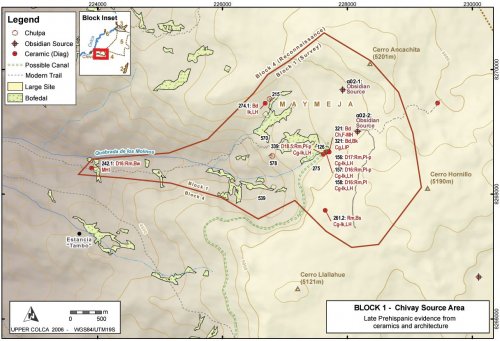6.5.1. Block 1 - Source
The 2003 Upper Colca project evidence from diagnostic artifacts indicate that Late Prehispanic activity in the obsidian source area principally took the form of pastoral activities, construction of mortuary architecture, and possible water control projects. Evidence from the Late Prehispanic in this area depends largely on the presence of diagnostic ceramics and architecture, but if the example provided by modern pastoralists in the area may serve as an indicator, architecture was likely akin to the traditional herder's shelter, and vessels were probably non-diagnostic utilitarian cooking vessels. A few utilitarian vessel sherds were observed in the Block 1 area, but the overall presence of pottery was relatively low. Another pattern that can be safely extrapolated into prehistory is that the residents of Maymeja were probably not wasteful with the pottery that they had transported up to the grazing area, because pottery is relatively scarce in this area. Thus, the ability of archaeologists to perceive activities during the period termed "Late Prehispanic" depends to some degree on recovering diagnostic features that differ from the well-established herder pattern that had predominated in the Maymeja area for probably 5000 years. Other good evidence of Late Prehispanic procurement and processing by local groups would come from consumption patterns observable in adjacent settlements during that time period, principally in Blocks 2 and 3 of the 2003 survey.
From the evidence of Chivay obsidian distributions, the quarry and the associated workshop may be expected to have continued use through the Tiwanaku period or LIP, and then it would decline in use during the Inka and the Colonial period. In the Colonial period with the widespread availability of metals and bottle glass, obsidian use was largely abandoned, except for minor applications by local pastoralists. Therefore, during the Hispanic period the quarry pit may have been abandoned and the quarry and workshop features would perhaps be covered by soil accumulation and ash deposits from nearby volcanoes after more than 500 years with little use.
As will be presented below, the 2003 survey found no diagnostic evidence of Tiwanaku, and no Colla (non-local LIP) materials in the quarry area. Limited Inka and Collagua-Inka pottery were encountered, and these Late Horizon ceramic distributions appear to have been primarily related to mortuary features and to the focus on the water and the grazing opportunities in the Maymeja area.

Figure 6-67. Block 1 Late Prehispanic features.
